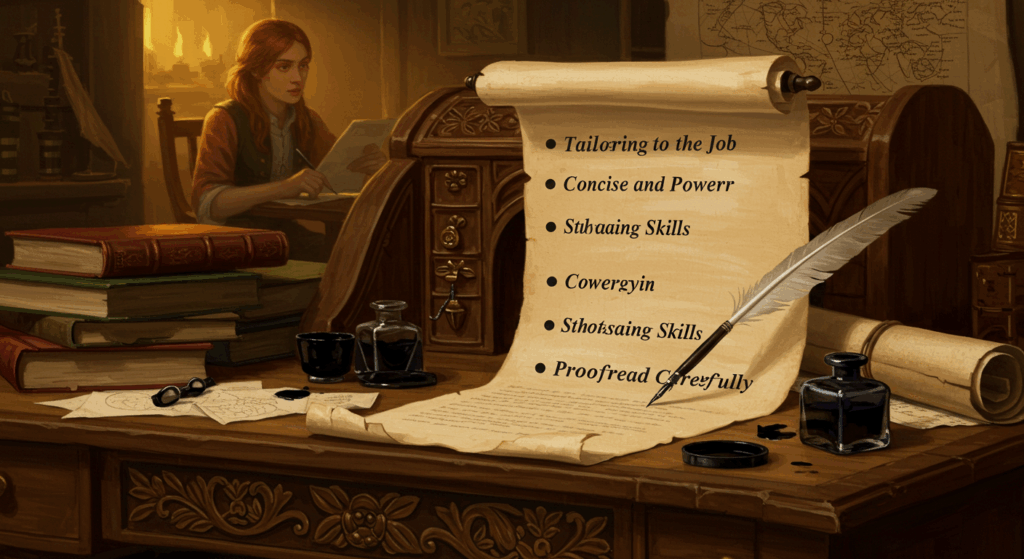As usual, cover letters have “ugh” energy. They feel like the spinach of job applications—technically good for you, rarely your first choice, and somehow always showing up when you just wanted mac ’n cheese (aka, your resume). But here’s the thing: a cover letter is your one-page chance to sound human, to connect dots your resume can’t, and to do some gentle persuasion. It’s the quick DM that makes the hiring manager actually want to click your profile.
If a resume is your highlight reel, a cover letter is the director’s commentary—short, personable, and very much about the purpose behind the scenes. It explains the structure of your story (how A → B → C led you here), and adds timely examples to show you’re not just “motivated,” you’re useful.
Also, ngl, most people either skip it or write one that reads like a Wikipedia page. That’s your advantage. Let’s make yours feel like a sincere, well-crafted note that says, “Hey, I get your problems. Here’s how I’ll help fix them.”
So… What Even Is a Cover Letter?
A cover letter is a short, tailored note you attach to your job application that introduces you, explains why you’re a great fit, and makes the case for moving you to the interview. It’s not a memoir, not a full resume rewrite, and definitely not a romantic sonnet to “To Whom It May Concern.”
Think of it as:
- A bridge between your resume and the job description
- A quick narrative that makes your experience make sense
- A professionally friendly message that shows you can communicate like a human (what a concept)
Your cover letter has one key purpose: increase your response rate. That’s it. Not to impress your English teacher. Not to fit every achievement you’ve ever had. Just to get you to the next step.
Why Cover Letters Still Matter (The Purpose)
If you’re asking “Do people even read these?”, fair. Not everyone. But the ones who do are often the ones making the decision. And they’re looking for a few signals:
- You get the role’s real problems.
You mirror the job description and name the priorities: revenue, growth, retention, performance, shipping on time, customer love. When your letter aligns with those, it feels like you’re already on the team. - You can write clearly and nice-ly.
A concise voice hints you’re organized, empathetic, and able to communicate—aka teamwork fuel. - You’re not spray-applying.
A tailored letter shows intention. People love intention. (Like when someone picks a specific Spotify playlist for you, not just “Top 50.”) - You translate bullets into impact.
Your resume says you “led a project.” Your cover letter explains the purpose, structure, and gives short examples: the problem, the move you made, and the measurable outcome.
Bottom line: the purpose of a cover letter is persuasion—with receipts.
Cover Letter vs. Resume: What Goes Where
- Resume: facts, bullet points, hard data, clean formatting.
- Cover letter: the “why” behind those facts, plus a quick story about how you solve problems like the ones in this job.
If your resume is the menu, your cover letter is the server’s recommendation: here’s what’s amazing, here’s why it fits your taste, and here’s what pairs well with it.
How Long Should It Be, and What Tone Works?
- Length: 250–400 words (roughly 3–5 short paragraphs). One page max.
- Tone: personable but professional. Think “friendly coworker,” not “bestie trauma dump.”
- Voice: write like you talk on your best day—clear, warm, confident, zero fluff. A little humor is fine; a stand-up routine is not.
If the company culture looks buttoned-up, lean crisp. If it’s more creative/tech/startup, you can loosen the collar. Either way, aim for respectful, human, and—definitley—concise.
The Structure That Works in 2025 (Simple, Skimmable, Effective)
Here’s a battle-tested structure:
- Hook (1–2 sentences).
A quick opener tailored to the company—something specific you admire, a shared value, or a recent initiative you can help with. - Bridge (1–2 sentences).
A sentence that aligns your background with their needs: “I’ve spent three years doing X and Y, and I’m excited to bring that to Z.” - Value Paragraph (3–5 sentences).
Three fast examples of relevant wins. Show before → after, tie it to metrics, and mirror the job description’s language. - Company Tie-In (2–3 sentences).
Show you get their product, audience, or roadmap. Mention a feature, metric, or challenge you can contribute to. - Close & Call-to-Action (1–2 sentences).
Light, confident, grateful. Invite a conversation.
That’s your structure. The purpose flows through it: get them nodding yes.
Step-by-Step: Writing Your Letter (with Mini Examples)
Step 1: Start with a Hook
Say something specific to them. Avoid “I’m writing to apply for [role].” They already know that.
Mini hook examples:
- “I love how your mobile onboarding gets users to their ‘aha’ moment in under two minutes—rare and very smart.”
- “Your recent push into LATAM is bold; I helped a SaaS team localize and double trial conversiomns in Mexico City and São Paulo.”
Step 2: Build the Bridge
One clean sentence that connects you to what they need.
Example:
“As a lifecycle marketer who raised 90-day retention by 18% at a B2C subscription app, I’m excited to help [Company] deepen loyalty during your upcoming membership rollout.”
Step 3: Drop Three Proof Points (the Value Paragraph)
Make them short, concrete, and aligned to the job.
Examples:
- “Redesigned onboarding emails → +22% activation (from 41% → 50%).”
- “Launched referral program that drove 12% of new paid users.”
- “Partnered with product on A/B tests; shipped 7 experiments/quarter.”
Step 4: Tie Yourself to Their World
Name a product, customer segment, or challenge they talk about.
Example:
“I’m especially excited about your creator tools; the new analytics dashboard could use lifecycle nudges at day 3, 7, and 14 to turn dabblers into weekly active creators.”
Step 5: Close Like a Human
Gratitude + invitation, no begging.
Example:
“Thanks for considering my application. I’d love to share how I’d map a 90-day experiment plan for the membership launch.”
This step-by-step flow keeps the structure tight while delivering examples that prove you’re not just vibes.
Real-World Examples (Short, Standard, and Switcher)
Here are three quick sample letters you can adapt. Keep the bones; swap the details.
Short Example (Startup, Product-ish)
Dear Hiring Team,
I’m a product-minded marketer who loves clean onboarding and messy spreadsheets. At Streamly, I helped move activation from 46% to 55% by simplifying the first-run experience and pairing it with two lifecycle nudges. I also worked with support to surface common drop-off reasons and cut time-to-value by ~30%.
Your push into short-form creator tools is exciting. I’ve shipped 20+ onboarding experiments for creators and would bring that playbook to your new analytics dashboard—especially day-3 and day-7 activation moments.
Thanks for reading. I’d love to chat about a 90-day test plan for the creator funnel.
Best,
Avery
Standard Example (Ops/Analyst, Larger Company)
Hello [Manager Name],
The Operations Analyst role at [Company] lines up with my favorite things: cleaning messy data, smoothing processes, and helping teams see around corners. At ParcelOne, I reduced “where is my order?” tickets by 27% by building a daily exception report and partnering with CX on proactive messaging. I also led an inventory accuracy project that took us from 92% to 98% within one quarter.
Your commitment to same-day delivery is ambitious; my experience in exception handling and route optimization could help hit those SLAs without burning out drivers. Happy to share a short deck on the alerting system we used to surface late scans before they became customer issues.
Thank you for your time,
Jordan
Career Switcher Example (Customer Support → UX)
Hi [Manager Name],
I’m transitioning from Customer Support to UX because I’ve spent three years listening to users at their most honest—and I want to fix the moments that frustrate them. At BrightBill, I analyzed 1,000+ tickets to map the top five pain points; that work informed a new payment flow that reduced “card failed” tickets by 35%.
I’ve completed a UX certificate and built prototypes in Figma (happy to share). I’m especially drawn to [Company]’s focus on accessibility and would love to contribute strong user empathy, rapid research, and clean interaction design to your team.
Appreciate your consideration,
Sam
Each of these follows the same structure and shows the purpose: to connect your story to their needs using crisp examples.
Templates You Can Copy (and Actually Use)
Simple Template (Fill-in-the-Blanks)
Dear [Hiring Manager Name],
I’m excited about the [Role Title] role at [Company] because [specific reason tied to their product/mission]. In my [current/previous] role at [Previous Company], I [impact verb] by [what you did], resulting in [number/metric].
Recently, I [second example of impact] which led to [metric/qualitative outcome]. I also [third example], partnering with [team] to [result/outcome]. These match your focus on [job requirement 1], [job requirement 2], and [job requirement 3].
I’m particularly interested in [specific project/feature/market they care about], and I’d love to help with [how you’d contribute]. Thank you for considering my application—I’d be happy to share a 30-60-90 plan.
Best,
[Your Name]
Email Body Version (When You’re Not Attaching a PDF)
Subject: [Role Title] – [Your Name]
Hi [Name],
I’m applying for [Role Title] at [Company]. I’ve spent [X years] doing [what you do] and recently [top win + metric]. I’m drawn to [Company]’s [product/mission] and would love to help with [specific initiative]. Resume and portfolio below—thanks for your time!
Best, [Your Name] | [LinkedIn] | [Portfolio]
Personalizing Without Spending 5 Hours (You Are Busy, I Get It)
Here’s a fast 15-minute method that keeps your letter sharp:
- Skim the job description and highllight the top 3 responsibilities.
- Visit the company site for 5 minutes: product pages, blog, careers page. Jot one detail that genuinely interests you.
- Match three wins from your resume to those responsibilities. Translate them into the same language the posting uses.
- Draft the five-part structure (hook, bridge, value, tie-in, close).
- Read out loud once and cut waffle words.
If you’re applying to multiple roles, keep a master doc of your best examples so you can swap quickly. It’s like a meal prep kit, but for your career.
What to Say If You Don’t Have “Enough” Experience
Use purpose and structure to your advantage:
- Purpose: Show you understand their problems and can learn fast.
- Structure: Pick 2–3 examples from school, projects, volunteering, or part-time work that map to the job’s responsibilities.
Translation tips:
- School project → “Led a 4-person team, shipped on deadline, presented findings to 30 classmates.”
- Retail → “Handled 50+ customers/shift, resolved issues, managed drawer with 100% accuracy.”
- Freelance → “Built 3 client websites, improved page speed by 35% avg.”
Employers love pattern-matching. Help them match.
Common Mistakes (and Easy Fixes)
- Too generic.
Fix: Mention a feature, team, or value unique to the company. - All about you, not them.
Fix: Mirror their priorities. Use their keywords naturally. - No numbers.
Fix: Add even small metrics: %, time saved, tickets reduced, reviews improved. - Long paragraphs.
Fix: Keep paragraphs 2–5 sentences. Skimmable wins interviews. - Repeating the resume line-for-line.
Fix: Expand on one or two bullets, don’t paste everything. - Formal to the point of robotic.
Fix: Conversational, not casual-casual. Like a good LinkedIn DM, not a text to your Chaos Group Chat. - Typos.
Fix: Read out loud. Use spellcheck. Ask a friend. (Yes, even one “manger” instead of “manager” can hurt. Ugh, tragic.)
Formatting Tips (Make It Clean, Not Extra)
- Length: one page, 250–400 words.
- Font: system fonts (Calibri, Arial, Times, Inter). 10.5–12pt.
- Spacing: 1.0 or 1.15. Margins ~1”.
- Header: match your resume header (name, email, phone, LinkedIn/portfolio).
- File name:
YourName-Company-Role-CoverLetter.pdf - Greeting: “Hi [Name],” or “Hello [Hiring Team],” (skip “To Whom It May Concern”).
- Sign-off: “Best,” “Thanks,” or “Sincerely”—whatever feels natural.
ATS, Keywords, and Keeping It Human
Yes, some companies use applicant tracking systems. No, you shouldn’t write like a robot. Use a few of the job description’s keywords (tools, responsibilities, domain terms), but weave them into real sentences. That way a human—and an algorithm—can both nod along.
Examples of phrases to include if relevant:
- “lifecycle marketing,” “SQL,” “Figma,” “SLAs,” “pipeline,” “roadmap,” “retention,” “OKRs,” “accessibility,” “React,” “customer insights.”
Use them sparingly. The purpose is clarity, not stuffing.
How to Research Quickly (Without Falling Into a Rabbit Hole)
- Website: product pages, pricing, docs.
- Recent news/blog: any launches or partnerships.
- LinkedIn: read the hiring manager’s or team’s recent posts.
- Glassdoor/Reddit: vibe-check, but grain of salt.
- Product trial: create an account; take screenshots; note friction.
Then bring one insight into your letter: a user journey, a feature gap, or a growth bet. That’s how you show thoughtfulness without writing a dissertation.
Add a Tiny 30-60-90 Flavor (Optional but Chef’s Kiss)
In one sentence, hint at what you’d do early on:
- 30 days: learn the stack, audit workflows, meet cross-functional partners.
- 60 days: ship small wins (one automation, one bug fix, one content refresh).
- 90 days: propose a roadmap (three experiments, one initiative, metrics to watch).
This micro-plan shows you think in systems. Hiring managers love systems.
Industry-Specific Phrases You Can Borrow
- Marketing/Growth: “activation,” “CAC,” “LTV,” “retention,” “funnel experiments.”
- Product/Design: “user research,” “information architecture,” “prototype,” “accessibility.”
- Engineering: “code reviews,” “observability,” “CI/CD,” “reliability,” “ownership.”
- Ops/Logistics: “forecast accuracy,” “throughput,” “exception handling,” “SLA adherence.”
- Customer Success/Support: “NPS/CSAT,” “deflection,” “playbooks,” “time to resolution.”
Use them as garnish, not the whole meal.
The Psychology (Make It Easy to Say Yes)
- Specific > generic. A single relevant example beats four vague ones.
- Confidence > apology. Don’t over-explain gaps; show readiness.
- Future-focused. A little “here’s what I’ll do next” helps them visualize you in the role.
- Gratitude. Respect their time. People remember how you made them feel.
Quick FAQ
Do I always need a cover letter?
If there’s a field for it or it’s requested—yes. If not required, include one when you have something targeted and useful to say. It can be the email body if that feels natural.
Who do I address it to?
Use the hiring manager’s name if public. Otherwise “Hi [Team Name]” or “Hello Hiring Team.”
Should I repeat my resume?
No. Use your best 2–4 examples that align with the role. Save the rest for the interview.
Do I need a mailing address/date block like a Victorian letter?
Nope. Modern letters can skip that. Put your contact info in the header and go.
Can I use AI to draft it?
Sure—but edit it to sound like you. Add details only you know. Authenticity wins.
Putting It All Together (A Mini Walkthrough)
Let’s say the job description wants: “optimize onboarding,” “improve retention,” and “partner cross-functionally.” Your structure:
- Hook: “Your onboarding gets people to value fast—love that.”
- Bridge: “I’ve helped two apps boost 30-day retention with better first-run experiences.”
- Value: three crisp examples (activation up 22%, referral program 12% of paid, seven growth experiments/quarter).
- Tie-In: “Your new creator analytics is a perfect place for lifecycle nudges; I’d map day-3/7/14 prompts.”
- Close: “Thanks—happy to share a 90-day test plan.”
That’s it. You can write that in 20 minutes if you’ve done the prep.
A Final, Polished Example (All the Pieces in One)
Hello Maya,
Your team’s push to help small sellers turn casual browsers into committed buyers is exactly the kind of challenge I love. In my last role at PopCart, I focused on activation and retention for a B2C marketplace—work that feels directly relevant to your next chapter.
- Redesigned the first-purchase flow and nudges → activation from 48% to 57%.
- Built a referral program that drove 11–14% of new paid buyers monthly.
- Partnered with Product + Support to reduce checkout friction, cutting “payment failed” tickets by 32%.
I’m especially excited about your new seller analytics. With a 30-60-90 plan, I’d audit onboarding, ship three retention experiments by week eight, and present a prioritized roadmap (with projected impact) by day 90. I admire [Company]’s commitment to sellers’ independence—my work has always centered on giving small teams compounding wins.
Thanks for your time. I’d love to share the experiment backlog I used at PopCart and discuss how it could translate to your marketplace.
Best,
Reese
See how the purpose is to earn the conversation, the structure is clean, and the examples are specific and metric-driven? That’s the vibe.
Wrap-Up: Make It Kind, Make It Clear, Make It You
You don’t need the perfect sentence or a thousand-word manifesto. You need a short note that shows you understand the role, have done something similar (or transferable), and are ready to help. That’s the whole purpose. Use the tight structure above. Swap in your best examples. Keep it human.
You’ve got this. Open a doc, set a 20-minute timer, write the hook, and ship your first draft. Then apply. Your future self—chilling with a better job, better team, and a way nicer coffee budget—is already cheering you on. Go hit send today.









